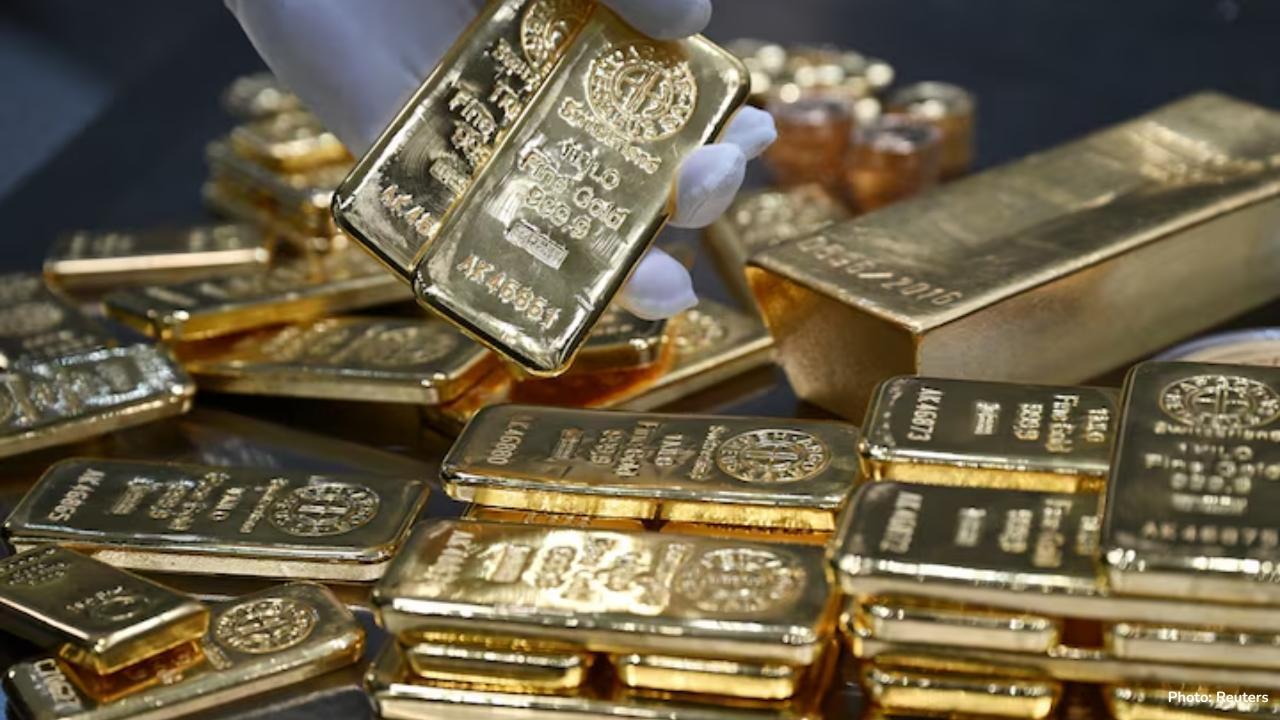
Post by : Monika
In 2025, gold prices have reached new record highs, exceeding $4,000 per ounce for the first time in history. This remarkable increase has caught the attention of investors, economists, and the general public alike. Gold, which has always been considered a safe investment during uncertain times, is now in unprecedented demand. Analysts point to several global and economic factors that have contributed to this surge, and many predict that gold will remain a key investment for years to come.
Global Conflicts and Uncertainty
One of the main reasons for the sharp rise in gold prices is the increasing number of conflicts around the world. The Russia-Ukraine war, which has been ongoing for over two years, has created major uncertainties in global energy supplies, trade, and markets. Similarly, tensions in the Middle East, including the Gaza conflict, have added to investor worries.
When political or military tensions rise, investors often seek safe havens for their money. Gold has historically been seen as a stable and secure asset during times of crisis. Unlike stocks or currencies, which can lose value rapidly during geopolitical crises, gold tends to hold its value or even increase. This explains why investors are flocking to gold in large numbers, pushing prices to record levels.
Economic Instability and Inflation
Economic instability is another significant factor driving gold prices higher. In many countries, inflation has been higher than expected, reducing the purchasing power of money. Rising prices for food, fuel, and basic goods have made investors nervous about traditional financial investments, such as stocks and bonds.
The U.S. dollar, which is considered the world’s primary reserve currency, has also been fluctuating. A strong or unstable dollar can impact global trade and investment, encouraging people to buy gold as a hedge against currency devaluation. In addition, concerns about the Federal Reserve’s independence and monetary policy have made investors cautious, prompting further investment in gold.
Central Bank Purchases
Central banks around the world have also played a major role in increasing the demand for gold. Countries like China, India, Russia, and Turkey have been buying large quantities of gold to strengthen their reserves and reduce reliance on foreign currencies. According to market analysts, central banks are expected to purchase around 1,000 metric tons of gold in 2025, continuing a trend of significant buying that has been observed over the past several years.
By adding gold to their reserves, central banks aim to protect their economies from currency risks, financial crises, and other uncertainties. This institutional buying has added extra pressure on the gold market, contributing to higher prices.
Impact of Interest Rates
Interest rates, especially in the United States, are another important factor influencing gold prices. The Federal Reserve has delayed raising interest rates, citing concerns about economic growth and financial stability. When interest rates are low or postponed, gold becomes more attractive to investors.
This is because gold does not earn interest or dividends like other financial instruments. When rates are high, investors may prefer interest-bearing assets, but when rates remain low, gold offers a safer alternative to protect wealth. The expectation of stable or lower interest rates has therefore fueled additional demand for gold in 2025.
Rising Demand for Precious Metals
The surge in gold prices has also influenced other precious metals. Silver, platinum, and palladium have all seen significant price increases. Silver, for instance, rose by 12% in September 2025 alone. Platinum and palladium, which are used in industrial applications and jewelry, have also benefited from growing investor interest and industrial demand.
The rising prices of these metals indicate a broader trend in the precious metals market. Investors are seeking not only gold but also other metals that can provide stability and protection against inflation, geopolitical risks, and economic uncertainty.
Exchange-Traded Funds (ETFs) and Investor Behavior
A notable trend in 2025 is the growing popularity of gold-backed exchange-traded funds, or ETFs. These funds allow investors to buy and sell gold without physically owning it. By holding gold in ETFs, investors can gain exposure to the metal while avoiding storage and security issues.
Global assets in gold ETFs have risen significantly, reaching 2.6% of total assets in 2025, up from 1.9% the previous year. U.S. gold ETF inflows have set a new annual record of $35 billion by September 2025, surpassing the previous record set in 2020. This demonstrates that institutional and individual investors alike are increasingly turning to gold as a secure investment.
Market Predictions and Future Trends
Financial experts and analysts predict that gold prices may continue to rise in the near future. Goldman Sachs, a major investment bank, has projected that gold could reach $4,900 per ounce by December 2026. The main drivers of this upward trend are expected to be ongoing geopolitical tensions, continued economic uncertainty, and strong demand from central banks and investors.
While short-term fluctuations in price are always possible due to market forces, the overall trend for gold in 2025 suggests that it will remain a favored investment for those seeking security. Analysts also note that as long as inflation, political instability, and global conflicts persist, the appeal of gold will remain strong.
Why People Invest in Gold
Gold has long been considered a “safe haven” for investment. Unlike paper currencies, which can lose value due to inflation or government policies, gold is a physical asset that retains intrinsic value. In times of crisis—whether economic, political, or military—investors often move their money into gold to protect their wealth.
In addition to its role as a hedge, gold is also used in jewelry, technology, and other industries. This dual role as both an investment and an industrial commodity makes it a unique and resilient asset in global markets.
Challenges and Risks
Despite its strong performance, investing in gold is not without risks. Price volatility can occur due to sudden changes in global events, economic data, or central bank policies. For example, if major conflicts were to resolve or if inflation were to drop significantly, gold prices might stabilize or even decline.
Investors also need to consider storage, security, and transaction costs if they purchase physical gold. While ETFs and digital gold solutions provide alternatives, understanding the risks and costs is essential for making informed decisions.
Impact on the Economy
The surge in gold prices has broader implications for the global economy. Rising gold prices can reflect underlying economic concerns, signaling uncertainty and risk in other investment areas. High gold prices may encourage governments and central banks to strengthen their reserves and reconsider monetary policies.
For countries that import gold, higher prices can increase costs and affect trade balances. For producers and miners, higher gold prices can boost revenues and profitability, leading to increased investment in exploration and production.
Global Perspective
The gold rush in 2025 is not limited to one country or region. Investors worldwide are participating, with significant interest from Asia, Europe, and the Americas. India, for example, is one of the largest consumers of gold, both for jewelry and investment purposes. Chinese investors and central banks are also heavily involved, further supporting global demand.
Gold’s global appeal lies in its ability to provide stability and security across borders. When other assets become risky or unpredictable, gold serves as a universal measure of value and a store of wealth.
The surge in gold prices in 2025 reflects widespread concerns about global conflicts, economic instability, and uncertainty in financial markets. Investors, central banks, and countries are all turning to gold as a safe haven, driving prices to record highs above $4,000 per ounce.
With continuing geopolitical tensions, inflationary pressures, and delayed interest rate hikes, gold is expected to remain a key investment choice. Its dual role as an industrial and investment commodity, along with its historical significance as a store of value, ensures that it will continue to attract attention from investors worldwide.
While challenges and risks remain, including market volatility and storage concerns, gold’s appeal as a secure and stable asset is stronger than ever. For now, the world’s gold rush is a clear sign that investors are seeking safety in an uncertain global environment, and gold remains the shining symbol of security and wealth preservation.










NBA Friday Recap: Powerhouse Wins for Miami, LA, Milwaukee, and Clippers
Miami, LA Lakers, Milwaukee, and Clippers triumphed in a thrilling NBA Friday, showcasing standout p

Doncic Shines with 49 Points in Lakers' 128-110 Victory over Timberwolves
Luka Doncic dazzles with 49 points as the Lakers secure a 128-110 win against the Timberwolves, show

Kings Triumph Over Jazz 105-104 with Last-Minute Sabonis Effort
The Sacramento Kings edged out the Utah Jazz 105-104, with Domantas Sabonis making the decisive shot

Argentina's Friendly Match Against India Delayed, New Date to be Announced
The friendly match between Argentina and India in Kochi has been postponed due to FIFA approval dela

Rohit and Kohli Conclude ODI Journeys in Australia with a Victory
Rohit Sharma and Virat Kohli bid adieu to Australian ODIs with a final win, forming a 168-run partne

George Russell's Wrestling Mask Antics at Mexican Grand Prix
George Russell donned a wrestling mask to enjoy the Mexican Grand Prix from the stands, providing a